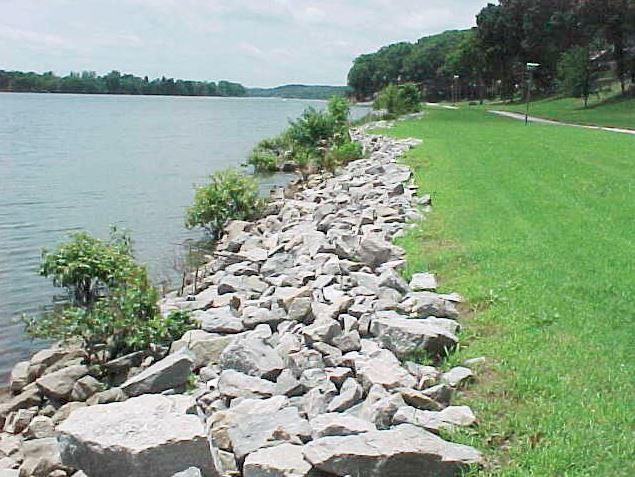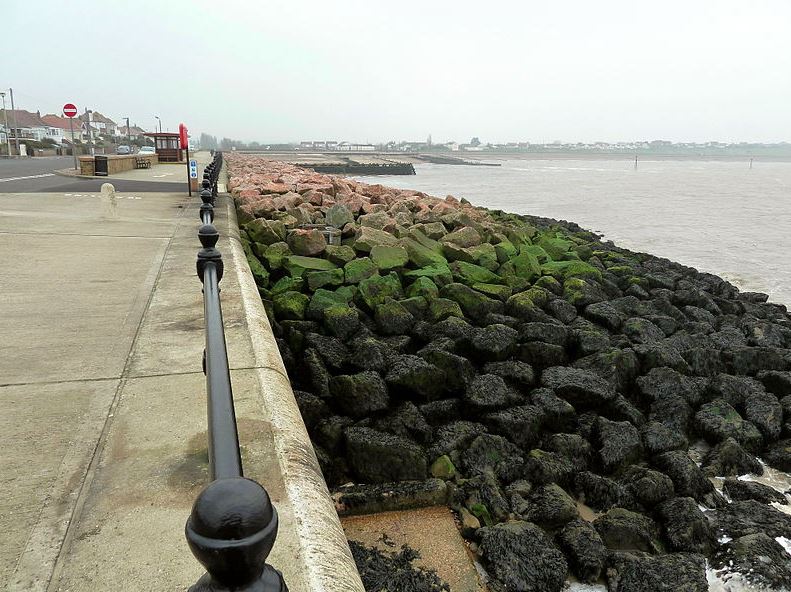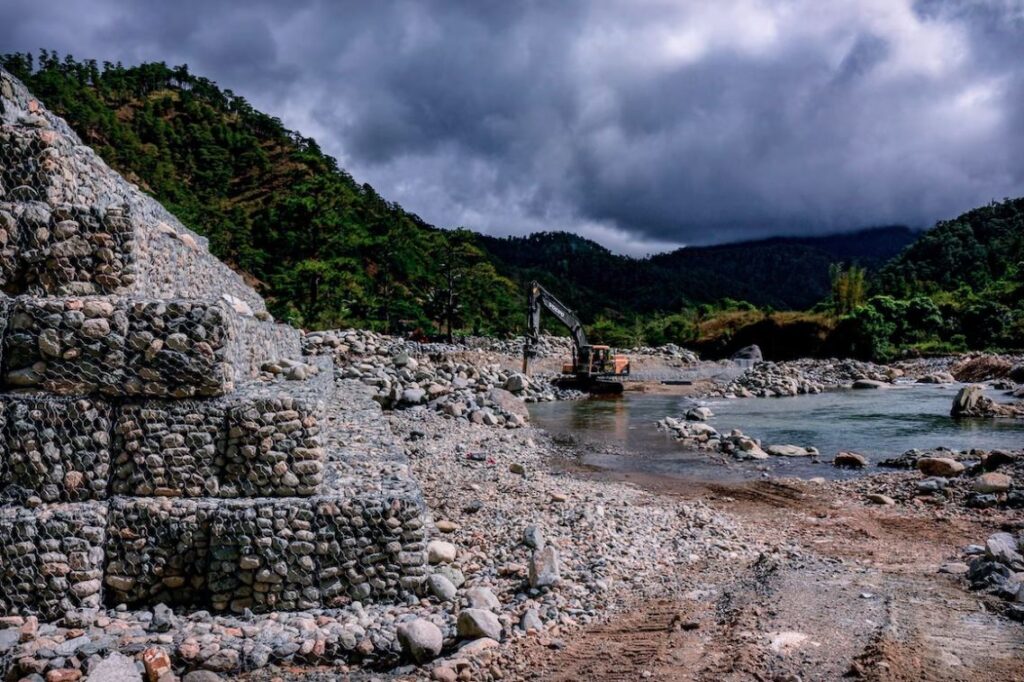Erosion is one of the most destructive forces on our planet, and it can have a devastating effect on both natural and man-made structures. Fortunately, there are measures that can be taken to prevent erosion from happening or at least minimize its damage. One such measure is called rip rapping, which involves placing large rocks along the banks of rivers or other waterways to help protect them from being eroded away by water currents.
Rip rapping has proven to be an effective method of erosion protection, as it creates a barrier that impedes the flow of water while also providing stability for riverbanks and shorelines against strong currents. Angular stone and smaller rocks come together with filter material to protect soil and vulnerable slopes. In this article we’ll look at how rip rapping works and why it’s important in helping prevent erosion.

What Is Rip Rapping?
Rip rapping is an effective way to prevent soil erosion, and it has been used for centuries to protect grade stabilization structures and waterways from the effects of wave action. It involves placing large rocks in strategic locations along a shoreline or river bank, forming a barrier that protects the area from erosion caused by waves or moving water when storm drains aren’t enough. Uniform riprap also absorbs energy from incoming waves, reducing their power and further protecting the shoreline or surrounding landscape. In addition to preventing erosion, rip rapping can also be used to create habitats for aquatic species as well as access points for swimming and fishing.
Benefits of using rip rapping as an erosion control measure
Cost-Effective:
Riprapping is a popular method used to protect soil and protect shorelines from the damaging effects of waves and currents. Rock riprap involves laying large stones or concrete blocks along a shoreline to provide a barrier against erosion. Although the initial costs of riprapping can be significant, it is generally considered a cost-effective solution in the long run.
Riprap is durable and can last for decades without requiring significant maintenance, saving money over time. Additionally, by protecting the shoreline from erosion, riprap can prevent costly damage to nearby infrastructure and property. Overall, riprapping is a proven and reliable way to protect shorelines and ensure long-term cost savings.

Long-Lasting Solution:
Rip rapping may seem like a simple solution, but it is incredibly effective in preventing soil erosion, protecting riverbanks, and stabilizing slopes. By layering sturdy rocks or concrete slabs along the vulnerable edges, rip rapping creates a durable barrier that redirects water flow and sustains the natural landscape. Unlike other erosion control methods that require frequent maintenance or costly repairs, rip rapping can withstand the test of time and harsh weather conditions.
The benefits of rip rapping extend beyond practicality, as it also adds a touch of natural beauty to the surroundings. With its long-lasting and environmentally friendly qualities, rip rapping is undoubtedly a wise choice for both public and private landowners looking to safeguard their property while preserving the environment.
Aesthetically Pleasing:
Rip rapping is an aesthetically pleasing approach to erosion control. The use of natural materials, like angular stone, blends in with the surrounding environment, increasing its appeal. In contrast, concrete walls can be an eyesore, negatively impacting the beauty of the environment they are supposed to protect.
Wildlife Habitat:
Rip rapping provides habitat for wildlife. Many animals, such as fish, use rocky habitats for shelter, feeding, and spawning. The rocks used in rip rapping can also become home to a variety of invertebrate species, serving as a stepping stone for a diverse range of wildlife.
Easy Installation:
Riprap installations have never been easier. This effective means of protecting other shoreline structures from erosion and wave damage can now be done quickly and efficiently. In the past, this process was time-consuming and labor-intensive, but with the advances in technology and equipment, it can now be accomplished in a fraction of the time.
With easy-to-use machinery and a team of experienced professionals, the installation process will be hassle-free. Smaller rocks can even be moved by hand although uneven surfaces could make that a bit difficult. With the added benefit of its durability, rip rapping is the perfect solution for your waterfront property. Trust us to protect your shore from the elements, and allow you to enjoy your waterfront worry-free.

Where to use it for Erosion Control
Erosion can wreak havoc on our soil and waterways, causing damage that can take years to repair. Fortunately, there is a solution that can help combat this issue: rip rapping. This technique involves placing large rocks or boulders along the banks of rivers, lakes and streams to protect them against the powerful forces of erosion.
Rip rapping is especially effective in areas where natural vegetation has been removed or disturbed, leaving the soil exposed and vulnerable to erosion. While it may not be the best solution in every situation, rip rapping is a cost-effective and environmentally-friendly means of erosion control that can prove invaluable in protecting our natural resources.
As A Flexible Solution
Whether it’s a riverbank, shore, or canal, well graded riprap is an effective solution in protecting infrastructure from erosion caused by water currents. Grouted riprap, also known as rock armor or rubble, consists of interlocking stones positioned in a sloping formation that deflects the force of waves and stream flow. The beauty of rip rap is its flexibility in adapting to the needs of the site.
For example, some areas may require larger boulders for added strength, while others may require finer rocks for a more natural look. Rip rap can also be implemented in different patterns and configurations to control water flow and enhance the aesthetic of the site. With so many options, it’s no wonder rip rapping has become a go-to solution in addressing coastal erosion and water current protection.
Steep Slope Solutions
Have you ever wondered if rip rapping works on steep slopes? Many people may assume that this erosion control technique is only effective on more gentle inclines, but research has shown that it can also work wonders on steeper slopes. Rip rapping involves placing large rocks or other materials along the base of eroding slopes, which helps to absorb any incoming water and redirect its flow. This process can be particularly useful on steep slopes, where the water velocity can be even greater and more damaging. In fact, rip rapping can be especially effective in preventing landslides and other forms of slope failure, making it a valuable tool for erosion control in many different settings.

What Filter Material Is Used In Rip Rap?
The answer is a combination of different materials that work together to provide stability and filtration. These materials can range from natural stone, such as granite or limestone, to synthetic materials like geotextile fabric or plastic mesh. Each material serves a specific purpose, with the natural stones providing the physical structure and the synthetic materials filtering out fine particles. Whether you’re considering using rip rap for a commercial or residential erosion control project, understanding the filter materials involved can help you make informed decisions and achieve optimal results.
What’s the difference between Graded, Grouted and Uniform riprap?
Graded riprap and uniform riprap are two types of stone used for erosion control and slope stabilization. While both types of riprap serve the same purpose, they differ in their appearance and how they are installed.
Graded riprap
This is a type of stone that is sorted by size and placed in layers, with the largest stones at the bottom and smaller stones at the top. The graded layers create a stable slope that is less likely to erode or shift over time. The larger stones at the bottom help to distribute the weight of the stone and prevent the smaller stones from settling into the soil. Graded riprap is typically used in areas with high water flow or strong waves, such as along shorelines or in riverbanks.
Grouted riprap
Grouted riprap is a type of erosion control technique that involves the use of a cement grout mixture to bind and stabilize riprap stones or boulders. The riprap stones are first placed in a desired pattern, and then a cement grout mixture is pumped through the voids to fill and stabilize the structure.
The grout mixture typically consists of cement, water, and sometimes additional materials such as sand or fly ash. The grouting process helps to prevent the riprap stones from shifting or moving due to water flow, wave action, or other environmental factors, and can provide additional stability to the overall structure.
Grouted riprap is often used in high flow areas or in situations where significant erosion control is necessary.
Uniform riprap
This is a type of stone that is all the same size and shape. Uniform riprap is usually installed in a single layer, making it faster and easier to install than graded riprap. However, because the stones are all the same size, they are more likely to shift and settle over time, particularly in areas with high water flow or strong waves. Uniform riprap is often used in areas where erosion control is needed but where water flow is not as strong, such as in small streams or drainage ditches.
Graded riprap is typically used in areas with high water flow or strong waves, while uniform riprap is used in areas where water flow is not as strong. Graded riprap is sorted by size and placed in layers, while uniform riprap is all the same size and shape and is usually installed in a single layer. Both types of riprap can be effective for erosion control and slope stabilization, but the choice of which to use will depend on the specific needs of the site.
Final Thoughts About Using Riprapping For Erosion Control
Rip rapping is an effective and cost-effective solution for erosion control. It requires minimal maintenance, blends in with the environment, provides habitat for wildlife, and can be installed quickly and easily. While it may not always be the best option in every situation, rip rapping is a great way to protect our natural resources from further damage caused by soil erosion. With proper planning and implementation of this technique, we can help preserve our shorelines and waterways while creating concentrated runoff and habitats that benefit both humans and nature alike.

